Related Research Articles

Syndicalism is a revolutionary current within the labor movement that seeks to unionize workers according to industry and advance their demands through strikes with the eventual goal of gaining control over the means of production and the economy at large. Developed in French labor unions during the late 19th century, syndicalist movements were most predominant amongst the socialist movement during the interwar period which preceded the outbreak of World War II.
Anarcho-syndicalism is a political philosophy and anarchist school of thought that views revolutionary industrial unionism or syndicalism as a method for workers in capitalist society to gain control of an economy and thus control influence in broader society. The end goal of syndicalism is to abolish the wage system, regarding it as wage slavery. Anarcho-syndicalist theory generally focuses on the labour movement. Reflecting the anarchist philosophy from which it draws its primary inspiration, anarcho-syndicalism is centred on the idea that power corrupts and that any hierarchy that cannot be ethically justified must be dismantled.
Red Clydeside was the era of political radicalism in Glasgow, Scotland, and areas around the city, on the banks of the River Clyde, such as Clydebank, Greenock, Dumbarton and Paisley, from the 1910s until the early 1930s. Red Clydeside is a significant part of the history of the labour movement in Britain as a whole, and Scotland in particular.

Dora Marsden was an English suffragette, editor of literary journals, and philosopher of language. Beginning her career as an activist in the Women's Social and Political Union, Marsden eventually broke off from the suffragist organization in order to found a journal that would provide a space for more radical voices in the movement. Her prime importance lies with her contributions to the suffrage movement, her criticism of the Pankhursts' WSPU, and her radical feminism, via The Freewoman. There are those who also claim she has relevance to the emergence of literary modernism, while others value her contribution to the understanding of Egoism.
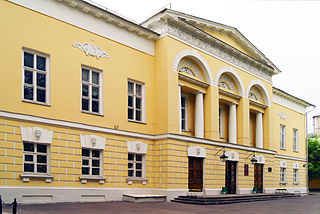
The International Lenin School (ILS) was an official training school operated in Moscow, Soviet Union, by the Communist International from May 1926 to 1938. It was resumed after the Second World War and run by the Communist Party of the Soviet Union; it continued until the end of the Soviet Union. The ILS taught both academic courses and practical underground political techniques with a view to developing a core disciplined and reliable communist political cadres for assignment in communist parties around the world.
The Miners' Federation of Great Britain (MFGB) was established after a meeting of local mining trade unions in Newport, Wales in 1888. The federation was formed to represent and co-ordinate the affairs of local and regional miners' unions in England, Scotland and Wales whose associations remained largely autonomous. At its peak, the federation represented nearly one million workers. It was reorganised into the National Union of Mineworkers in 1945.

John Saville was a Greek-British Marxist historian, long associated with University of Hull. He was an influential writer on British labour history in the second half of the twentieth century, and also known for his multi-volume work, the Dictionary of Labour Biography, edited in collaboration with others.
The 1993 DundeeTimex strike was a major industrial dispute which took place in Dundee, Scotland, in 1993. The dispute, which was notable for its level of picket-line violence and the involvement of women, ended with the closure of the Timex plant in the city after 47 years. It is considered by historians to be the last of the large industrial disputes of late 20th century Britain.

Thomas Ellis Naylor was a Labour Party politician in the United Kingdom.

A movement to fight for women's right to vote in the United Kingdom finally succeeded through acts of Parliament in 1918 and 1928. It became a national movement in the Victorian era. Women were not explicitly banned from voting in Great Britain until the Reform Act 1832 and the Municipal Corporations Act 1835. In 1872 the fight for women's suffrage became a national movement with the formation of the National Society for Women's Suffrage and later the more influential National Union of Women's Suffrage Societies (NUWSS). As well as in England, women's suffrage movements in Wales, Scotland and other parts of the United Kingdom gained momentum. The movements shifted sentiments in favour of woman suffrage by 1906. It was at this point that the militant campaign began with the formation of the Women's Social and Political Union (WSPU).
The Industrial Syndicalist Education League (ISEL) was a British syndicalist organisation which existed from 1910 to 1913.
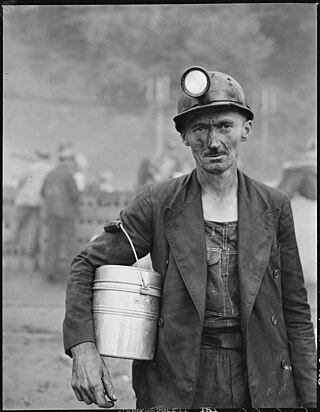
People have worked as coal miners for centuries, but they became increasingly important during the Industrial revolution when coal was burnt on a large scale to fuel stationary and locomotive engines and heat buildings. Owing to coal's strategic role as a primary fuel, coal miners have figured strongly in labor and political movements since that time.
The Irish Women's Suffrage Society was an organisation for women's suffrage, founded by Isabella Tod as the North of Ireland Women's Suffrage Society in 1872. Determined lobbying by the Society ensured the 1887 Act creating a new city-status municipal franchise for Belfast conferred the vote on persons rather than men. This was eleven years before women elsewhere Ireland gained the vote in local government elections.

The British Socialist Party (BSP) was a Marxist political organisation established in Great Britain in 1911. Following a protracted period of factional struggle, in 1916 the party's anti-war forces gained decisive control of the party and saw the defection of its pro-war right wing. After the victory of the Bolshevik Revolution in Russia at the end of 1917 and the termination of the First World War the following year, the BSP emerged as an explicitly revolutionary socialist organisation. It negotiated with other radical groups in an effort to establish a unified communist organisation, an effort which culminated in August 1920 with the establishment of the Communist Party of Great Britain. The youth organisation the Young Socialist League was affiliated with the party.
A general strike is a strike action in which participants cease all economic activity, such as working, to strengthen the bargaining position of a trade union or achieve a common social or political goal. They are organised by large coalitions of political, social, and labour organizations and may also include rallies, marches, boycotts, civil disobedience, non-payment of taxes, and other forms of direct or indirect action. Additionally, general strikes might exclude care workers, such as teachers, doctors, and nurses.
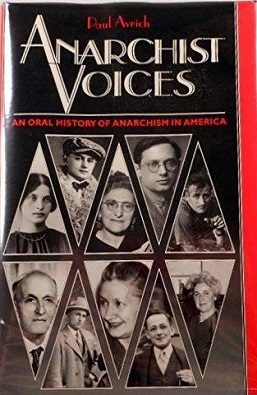
Anarchist Voices: An Oral History of Anarchism in America is a 1995 oral history book of 53 interviews with anarchists over 30 years by Paul Avrich.
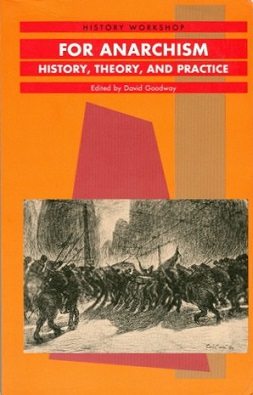
For Anarchism: History, Theory, and Practice is a 1989 book of essays by anarchists on the history, theory, and practice of anarchism. The essays, derived from Leeds Anarchist Research Group meetings in 1985 and 1986, was edited by David Goodway and published by Routledge.
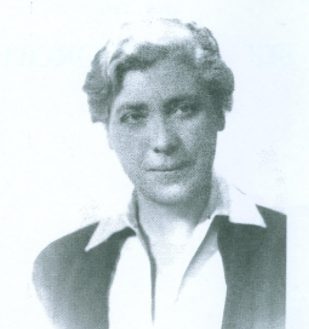
Dorothy Elizabeth Evans was a British feminist activist and suffragette. On the eve of World War I she was a militant organiser for the Women's Social and Political Union twice arrested in Belfast on explosives charges. She broke with Christabel Pankhurst and the WSPU in 1914 over their support for the war, and remained until the end of her life an active peace and women's equality campaigner.
Anarchist archives preserve records from the international anarchist movement in personal and institutional collections around the world. This primary source documentation is made available for researchers to learn directly from movement anarchists, both their ideas and lives.

Martha Jane Bury was an English suffragist and co-operative organiser active in the Co-operative Women's Guild.
References
- 1 2 Béliard, Yann (January 2014). "Introduction: Revisiting the Great Labour Unrest, 1911-1914". Labour History Review. 79 (1): 1–17. doi:10.3828/lhr.2014.1. ISSN 0961-5652.
- ↑ Béliard 2014.
- ↑ Thompson, James (January 2014). "The Great Labour Unrest and Political Thought in Britain, 1911-1914". Labour History Review. 79 (1): 37–54. doi:10.3828/lhr.2014.3. ISSN 0961-5652.
- 1 2 3 Sires, Ronald V. (September 1955). "Labor Unrest in England, 1910–1914". The Journal of Economic History. 15 (3): 246–266. doi:10.1017/s0022050700057697. ISSN 0022-0507. S2CID 154519628.
- 1 2 3 4 O'Connor, Emmet (January 2014). "Old Wine in New Bottles? Syndicalism and 'Fakirism' in the Great Labour Unrest, 1911-1914". Labour History Review. 79 (1): 19–36. doi:10.3828/lhr.2014.2. ISSN 0961-5652.
- 1 2 3 Bantman, Constance (January 2014). "The Franco-British Syndicalist Connection and the Great Labour Unrest, 1880s-1914". Labour History Review. 79 (1): 83–96. doi:10.3828/lhr.2014.5. ISSN 0961-5652.
- 1 2 3 Darlington, Ralph (2020-10-24). "The pre-First World War British women's suffrage revolt and labour unrest: never the twain shall meet?". Labor History. 61 (5–6): 466–485. doi:10.1080/0023656x.2020.1836612. ISSN 0023-656X. S2CID 204768250.
- ↑ Richards (2014). "Model Citizens and Millenarian Subjects: Vorticism, Suffrage, and London's Great Unrest". Journal of Modern Literature. 37 (3): 1. doi:10.2979/jmodelite.37.3.1. ISSN 0022-281X. S2CID 154928566.
- ↑ Villis, Tom (January 2005). "Elitism and the revolt of the masses: reactions to the 'great labour unrest' in the New Age and New Witness circles". History of European Ideas. 31 (1): 85–102. doi:10.1016/j.histeuroideas.2003.08.010. ISSN 0191-6599. S2CID 143649210.
- ↑ Bantman, Constance (2006). "Internationalism without an International? Cross-Channel Anarchist Networks, 1880-1914". Revue belge de philologie et d'histoire. 84 (4): 961–981. doi:10.3406/rbph.2006.5056. ISSN 0035-0818.